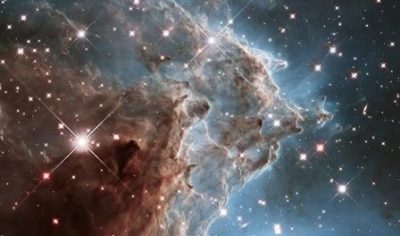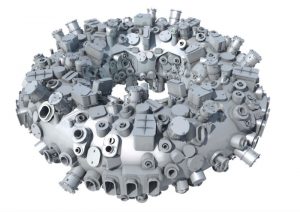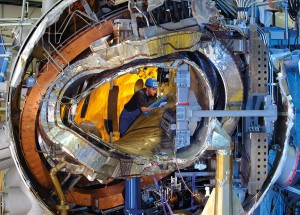At the JET reactor at Culham Centre for Fusion Energy, the film maker Tom Scott talks to the engineers about fusion power, being the hottest place in the solar system, deliberate disruptions, and about the surround-sound speakers that give a diagnostic test you might not expect.
Mervi Mantsinen
Nature Physics Insight in Fusion

Harnessing the energy produced in nuclear fusion reactions is an ongoing grand challenge. Recent Nature Physics Insight focuses on the achievements made so far and the trials ahead, highlighting that at the core of nuclear fusion lies some fascinating physics.
Playing catch up: can the stellarator win the race to fusion energy?
Power Technology has published an interesting article on fusion research, given the first promising results from the new Wendelstein 7-X stellarator device at the Max Planck Institute of Plasma Physics.
Wendelstein 7-X produced its first hydrogen plasma in February 2016, sparking speculation that the stellarator could overtake the tokamak as the leading experimental form of nuclear fusion energy production.
Spring visit to the JET tokamak

Over the past few days (4-12 April 2016) our Fusion group manager Mervi Mantsinen visited the JET tokamak at Culham, United Kingdom, to take part in the EUROfusion experimental JET campaign.
Physics World Focus On Nuclear Energy
April 2016 edition of Physics World has a focus issue devoted to nuclear energy: fission and fusion. It contains several interesting fusion articles including ITER, private fusion ventures and Wendelstein 7-X. Check it out here.
Twists and turns Germany’s Wendelstein 7-X stellarator will use a complex magnetic-field design to sustain a hydrogen plasma for about 30 min. (IPP/Wolfgang Filser )
10 Cool Facts About Fusion Energy

- It’s natural. In fact, it’s abundant throughout the universe. Stars – and there are billions and billions of them – produce energy by fusion of light atoms.
- It’s safe. There are no dangerous byproducts. It produces some radioactive waste, but that requires only decades to decay, not thousands of years. Further, any byproducts are not suitable for production of nuclear weapons.
- It’s environmentally friendly. Fusion can help slow climate change. There are no carbon emissions so fusion will not contribute to a concentration of greenhouse gases that heat the Earth. And it helps keep the air clean.
- It’s conservation-friendly. Fusion helps conserve natural resources because it does not rely on traditional means of generating electricity, such as burning coal.
- It’s international. Fusion can help reduce conflicts among countries vying for natural resources due to fuel supply imbalances.
- It’s unlimited. Fusion fuel – deuterium and tritium – is available around the world. Deuterium can be readily extracted from ordinary water. Tritium can be produced from lithium, which is available from land deposits or from seawater.
- It’s industrial scale. Fusion can power cities 24 hours a day regardless of weather.
- It’s exciting. Fusion produces important scientific and engineering breakthroughs and spinoffs in its own and other fields.
- It’s achievable. Fusion is produced in laboratories around the world and research is devoted to making it practicable.
- It’s the Future. Fusion can transform the way the world produces energy.
Source: Princenton Plasma Physics Laboratory (Larry Bernard)


